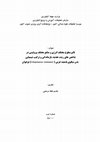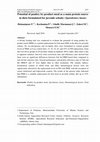Papers by fatemeh Hekmatpour
Advanced Aquaculture Sciences Journal, Feb 19, 2021
Advanced Aquaculture Sciences Journal, Feb 19, 2021

Legumes - Volume 2 [Working Title], 2021
Aquaculture produce a great portion of aquatic derived proteins for human in the world. It has th... more Aquaculture produce a great portion of aquatic derived proteins for human in the world. It has the highest and the fastest growth rate among the protein producing industries. Fish meal (FM) is the main and the most expensive ingredient for aquafeeds production. It provides protein, essential amino acids, energy, minerals and vitamins in aquafeeds. Given the current rapid development of aquaculture industry the competition for limited global supplies of FM may reduce its availability and elevate its price. Thus, finding high quality, economic and environmentally friendly alternative protein sources (APS) for aquafeeds production is vital for sustainability of the aquaculture industry. Among various APS, legumes have been proved to be promising APS because they have medium protein content with suitable amino acid profile, high digestible protein and energy levels, and appropriate minerals and vitamins for the most cultured aquatic species. They also are cost-effective and highly acces...

The present study was carried out in order to establish an economical affective diet so that the ... more The present study was carried out in order to establish an economical affective diet so that the white leg shrimp grows well in the suthern part conditin of Iran. With the consideration of 3 dietary energy levels (E1=262, E2=312 and E3=362 kcal 100 g -1diet) and 6 ratios of fish meal:soybean meal (P1=100%, P2=80%, P3= 60%, P4=40%, P5= 20% and P6=0%), 18 experimental diets were established. Completely randomized design was used to assign 54 polyethylene 300 litrs round tanks provided by aeration and flow through water systems and was stocked by 19 juvenile as 3 replicates to each shrimps (0.77±00 g). After 56 days growing period maximum growth and nutritional performances were respectively observed in the P6E1(containing 100% soybean meal and 262 kcal 100 g -1diet) and P5E1(containing 80% soybean meal and 262 kcal 100 g -1diet). Also most survival rate of the shrimp was in the P5E2 (containing 80% soybean meal and 312 kcal 100 g 1diet) and P3E3 (containing 40% soybean meal and 362 kc...

Fish Physiology and Biochemistry, 2019
A 60-day experiment was conducted to evaluate the effect of dietary fish meal (FM) replacement wi... more A 60-day experiment was conducted to evaluate the effect of dietary fish meal (FM) replacement with poultry by-product meal (PBM) on digestive enzymes, non-specific serum enzyme activity, and serum biochemical parameters of juvenile sobaity sea bream, Sparidentex hasta, weighing 29.27 ± 0.06 g. PBM replaced 0, 15, 25, 35, 45, and 55% of dietary FM in the isoproteic (50%) and isocaloric (21 kJ g −1) experimental diets. The final body weight, percentage weight gain, specific growth rate, and protein efficiency ratio were higher in PBM15, 25, and 35 than in control, PBM45, and 55. Digestive lipase and amylase activity did not differ significantly between the dietary treatments. Significantly lower trypsin and higher chymotrypsin activity were observed at PBM55 and 45, respectively. Digestive alkaline phosphatase (ALP) increased, whereas protein apparent digestibility coefficients (ADC) decreased significantly with increasing levels of PBM above 35%. Hematocrit, hemoglobin, mean corpuscular hemoglobin concentration, serum albumin, globulin, total protein, glucose, urea, uric acid, and aspartate aminotransferase did not show any significant differences between the treatments. Serum ALP, cholesterol, and calcium were higher in PBM diets than in the control diet, whereas an inverse trend was observed in triglyceride. Protein digestibility and trypsin activity and serum biochemical indices suggest that fish meal protein could be reduced up to 45% by the inclusion PBM in the formulated diets for S. hasta juveniles without any adverse effect on its overall performance.

Lithuanian Journal of Physics, 2020
Here we present a study of the nickel-assisted etching applied to form uniform black silicon laye... more Here we present a study of the nickel-assisted etching applied to form uniform black silicon layers on crystalline silicon substrates. We related the parameters used for technological process control (etchant, nickel thickness) to parameters of the obtained surface and explain the correlation using the etching model responsible for etching of the silicon covered by a thin nickel film. The increase in the thickness of the metal catalyst did not suppress the etching completely but allowed one to tune the roughness of the silicon surface. The rate of the electrochemical etching was additionally changed by adaptation of the proportion of components in the complex etchant. Depending on the intentionally selected conditions, the duration of the optimized process was from 3 to 10 min. The lowest optical reflection commonly accepted as the black silicon surface was obtained for the mixture with a low amount of the active etchant component. It was demonstrated that the method is acceptable t...

Animal Feed Science and Technology, 2018
Abstract A 60-day experiment was conducted to evaluate the effect of replacement of fish meal (FM... more Abstract A 60-day experiment was conducted to evaluate the effect of replacement of fish meal (FM) with poultry by-product meal (PBM) on growth performance and feed utilization of juvenile sobaity sea bream (Sparidentex hasta). PBM replaced 0, 15, 25, 35, 45 and 55% of dietary FM in the isoproteic (500 g kg−1) and isocaloric (21 kj g−1) experimental diets. Sobaity sea bream with an average initial weight of 29.27 ± 0.06 g were randomly assigned to 18 tanks (6 treatments with triplicates each) at an initial stocking density of 20 fish per tank. The final body weight, weight gain, specific growth rate, protein efficiency ratio and nitrogen retention efficiency were higher in fish fed PBM15, 25 and 35 diets than in fish fed the control, PBM45 and 55 diets. Feed conversion ratio, nitrogen and phosphorus wastage did not show significant differences in PBM0, 35, 45 and 55. Increased retention of arginine, lysine, methionine, histidine and taurine was observed at lower dietary content of the respective amino acids. The morphometric indices, body proximate composition and amino acid profile were not significantly affected by the dietary treatments. Apparent digestibility coefficients (ADC) of dry matter, lipid and calcium in fish fed PBM diet did not show significant differences with PBM0. Protein ADC was significantly decreased with increased PBM level from 35%. Our results indicated that using fish meal and PBM in combination lead to improved growth and feed utilization of sobaity sea bream when compared to treatments using FM alone as the dietary protein source. Fish meal protein could be replaced up to 55% by PBM in the formulated diets of S. hasta juveniles without any negative effects on growth performance, feed utilization and whole body amino acid profile.

Iranian Journal of Fisheries Sciences, 2019
60-day feeding trial was conducted to evaluate the potential of using poultry by-product meal (PB... more 60-day feeding trial was conducted to evaluate the potential of using poultry by-product meal (PBM) as partial replacement of fish meal (FM) in the diets for juvenile sobaity. Six iso-nitrogenous and iso-lipidic diets were formulated to contain graded levels of PBM, at 0 (as control diet), 15, 25, 35, 45, and 55% of FM replacement. Each diet was fed to groups of 20 juvenile sobaity in triplicate 300-l tanks, thrice a day to apparent satiation. Survival, feed conversion ratio and efficiency ratio showed that there were no significant differences between fish fed PBM based diets compared to fish fed the reference diet. Growth performance and protein efficiency ratio of fish fed the PBM15 and 25 was higher than other treatments. The somatic indices, biochemical content of whole body and fillet, hematological factors were not significantly affected by the replacement level of FM with PBM, with the exception of serum cholesterol and triglyceride content. The results of the present study ...

Iranian Journal of Fisheries Sciences, 2020
A two-month feeding trial was conducted to evaluate the effect of partial replacement of fish mea... more A two-month feeding trial was conducted to evaluate the effect of partial replacement of fish meal (FM) by soybean protein (SP) alone or in combination with lysine (Lys) and methionine (Met) supplementation in practical diets for silvery-black porgy juveniles (16.7±0.1 g). Seven isoproteic (ca. 50% crude protein) and isoenergetic (ca. 22.4 MJ kg-1) diets were formulated in which 45% (SP45), 60% (SP60) and 75% (SP75) of FM protein were replaced by SP and the control diet (FM) was prepared with FM as the major source of protein. In SP45+, SP60+ and SP75+ diets, 45 to 75% of FM was replaced by SP with supplementing blends of Lys and Met. Growth performance, feed utilization, and protein and lipid digestibility decreased with increasing dietary SP levels (p<0.05). Fish fed SP75 had the highest whole body lipid content, but with the lowest whole body arginine, lysine, histidine, phenylalanine and taurine concentrations (p<0.05). Supplementing Lys and Met in SP based diets did not i...

Uploads
Papers by fatemeh Hekmatpour